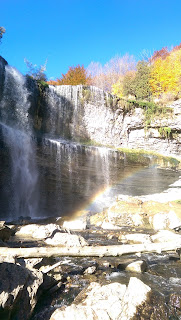Hi again, and welcome back to my blog!
This second challenge is about the history of water in my community and watershed. I'm an explorer, so I've chosen Option 3, where I've been tasked to find 3 water-related landmarks in my neighbourhood.
Thank goodness the weather has remained nice these days because it made my exploring much easier! In the course of wandering around the Toronto area, I've learned a lot about the history of the city, and am excited to share my findings with you.
In Toronto, there are two prominent rivers that run into Lake Ontario - Humber River and Don River. All of them (Humber River, Don River, and Lake Ontario) have interesting tidbits of history, and I've found landmarks relating to each. Here goes:
1. Humber Bay Arch Bridge
 |
| Photo taken on one of my recent bike rides along the Martin Goodman Trail |
This is a beautiful bridge. Over the past few years, I've biked or run on this bridge many times, and have always marveled at its architecture and beauty. However, it was not until this water challenge that I actually sat down to research its history.
The bridge is located where the Humber River empties into Lake Ontario, and it connects what was "Old Toronto" with "Etobicoke". It sits atop a trading route that was used by Aboriginal Peoples for more than 200 years, and the bridge's architecture was inspired by this history. There was an Indigenous art consultant involved in the planning and design of the bridge, and this is visible in the bridge today. For example, you will see the triangular patterns along the top of the bridge. This represents the Thunderbird, which has cultural significance to the Aboriginal Peoples.
 |
Thunderbird
Photo source: http://occasionaltoronto.blogspot.ca/2012_06_01_archive.html |
Next time you're at the bridge, remember to also look underneath it where you will find displays of turtles, canoes, snakes and salmon.
2. Salmon in the Don River
 |
| Salmon swimming up the Don |
A few years back, I saw salmon swimming upstream in the Don River all the way up near Steeles Avenue (the northernmost border of the Toronto). I had not seen the salmon there in years prior, and started to wonder why.
I found some answers at
www.discoverthedon.ca. It turns out that salmon have only been able to swim up the Don River within the last two decades, because there were previously in-stream barriers that prevented them from swimming past the lower 3km. Thanks to the efforts of the Toronto Region Conservation Area. Feel free to click the link above to learn more!
3. Front Street - the Old Shoreline of Lake Ontario
 |
| Standing on Front Street facing south towards Lake Ontario |
For those living in downtown Toronto, the history of the Lake Ontario shoreline is fascinating. Back in the day, Front Street was the waterfront area. Then the area south of it was filled in (with garbage), and new streets were built. So Lake Shore Boulevard and Queens Quay West became the streets closest to the shoreline.
What's interesting is the amount of development that has taken place on this landfill since its inception. Despite the difficulties and added costs of building on contaminated and softer soil/land, today you'll see countless condominiums south of Front Street, along with Toronto's iconic CN Tower and the Rogers Centre.
Whereas Toronto's waterfront used to be an industrial port, it is now home to a mixed-use strip and a beautiful multi-use trail. I took a bike ride recently along the Martin Goodman Trail and took some pictures to share with you all:
 |
| Sunset on the waterfront |
 |
| Toronto police on horseback - moonlight over Lake Ontario |
Hope you enjoyed the photos and the stories! Until next time =)








